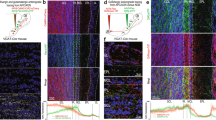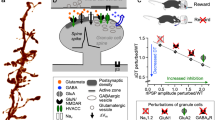Abstract
Olfactory bulb processing results from the interaction of relay neurons with two main categories of interneurons which mediate inhibition in two distinct layers: periglomerular cells and granule cells. We present here a neural model of the mammalian olfactory bulb which allows to separately investigate the functional consequences of the two types of interneurons onto the relay neurons responsiveness to odors. The model, although built with simplified representations of neural elements generates various aspects of neural dynamics from the cellular to the populational level. We propose that the combined action of centrifugal control at two different layers of processing is complementary: reduction of the number of active relay neurons responding to a given odorant through increased activity of periglomerular cells, and an increase of response intensity of active mitral cells through decrease of granule cell inhibition.
Similar content being viewed by others
References
Adrian ED (1950) The electrical activity of the mammalian olfactory bulb. Electroencephal. Clin. Neurophysiol. 2:377–388.
Bhalla U, Bower JM (1993) Exploring parameter space in detailed single neuron models: Simulations of the Mi and Gr cells of the olfactory bulb. J. Neurophysiol. 69:1948–1965.
Brennen P, Kaba H, Keverne EB (1990) Olfactory recognition: A simple memory system. Science 250:1223–1226.
Buonoviso N, Chaput M (1990) Response similarity to odors in olfactory bulb output cells presumed to be connected to the same glomerulus: Electrophysiological study using simultaneous single-unit recordings. J. Neurophysiol. 63:447–454.
Buonviso N, Chaput MA, Berthommier F (1992) Temporal pattern analysis in pairs of neighboring Mi cells. J. Neurophysiology 68(2):417–424.
Chaput MA, Holley A (1980) Single unit responses of olfactory bulb neurons to odor presentation in awake rabbits. J. Physiol. (Paris) 76:551–558.
Duchamp-Viret P, Duchamp A (1993a) GABAergic control of odour-induced activity in the frog olfactory bulb: Electrophysiological study with picrotoxin and bicuculline. Neurosci. 53:11–120.
Duchamp-Viret P, Duchamp A (1993b) GABAergic control of odour-induced activity in the frog olfactory bulb: Possible GABAergic modulation of Gr cell inhibitory action. Neurosci. 56:905–914.
Edelman JA, Freeman WJ (1990) Simulation and analysis of a model of Mi/Gr cell population interactions in the mammalian olfactory bulb. Proc. IJCNN-90-Wash-DC 1:62–65.
Elaagouby A, Gervais R (1991) Acetycholine-induced long-lasting enhancement in excitability of output cells of the rat olfactory bulb. Neuroreport 3:10–12.
Elaagoub A, Ravel N, Gervais R (1992) Cholinergic modulation of excitability in the rat olfactory bulb. Effect of local application of cholinergic agents on evoked field potential. Neurosci. 45:653–662.
Erdi P, Gröbler T, Barna G, Kaski K (1993) Dynamics of the olfactory bulb: Bifurcations, learning and memory. Biol. Cybern. (69):57–66.
Freeman W 1975. Mass Action in the Nervous System. Academic Press, New York.
Freeman W, Schneider WS (1982) Changes in spatial patterns of rabbit olfactory EEG with conditioning to odors. Psychophysiol. 19:44–56.
Freeman WJ, Skarda C (1985) Spatial EEG patterns, non linear dynamics and perception: The neo-Shrerringtonian view. Brain Res. Rew. 10:147–175.
Fuster JM, Jervey JP (1981) Inferotemporal neurons distinguish and retain behaviorally relevant features of visual stimuli. Science 212:952–955.
Holley A (1991) Neural coding of olfactory information. In: TV Getchell et al. Smell and Taste in Health and Disease, New York, Raven Press. pp. 329–343.
Kaba H, Hayashi Y Higuchi, Takanishi S (1994) Induction of an olfactory memory by the activation of a metabotropic glutamate receptor. Science 26:262–264.
Kalivas P (1993) Neurotransmitter regulation of dopamine neurons in the ventral segmental area. Brain Res. Rev. 18:75–113.
Kasa P, Hlavati I, Dobo E, Wolf A, Joo F, Wolff JR (1995) Synaptic and non-synaptic cholinergic innervation of the various types of neurons in the main olfactory bulb of adult: Immunocytochemistry of choline and acetyltransferase. Neurosci. 67:667–677.
Kauer JS (1974) Response patterns of amphibian olfactory bulb neurons to odor stimulation. J. Physiol. 243:695–715.
Kendrick KM, Levy F, Keverne EB (1992) Changes in the sensory processing of olfactory signals induced by birth in sheep. Science 256:833–836.
Keverne EB, Levy F, Guevara-Guzman MR, Kendrick KM (1993) Influence of birth and maternal experience on olfactory bulb neurotransmitter release. Neurosci. 56:557–565.
Lejeune H, Jourdan F (1994) Acetylcholinesterase-containing intrinsic neurons in the rat amin olfactory bulb: Cytological and neurochemical features. Europ. J. Neurosci. 6:1432–1444.
Levy F, Gervais R, Kindermann U, Orgeur, P, Piketty V (1990) Importance of-noradrenergic receptors in the olfactory bulb of sheep for recognition of lambs. Behav. Neurosci. 104:464–469.
Li Z, Hopfield JJ (1989) Modeling the olfactory bulb and its neural oscillatory processings. Biol. Cybern. 61:379–392.
Li Z (1990) A model of olfactory adaptation and sensitivity enhancement in the olfactory bulb. Biol. Cybern. 62:349–361.
Linster C, Masson C, Kerszberg M, Personnaz L, Dreyfus G (1993) Computational diversity in a formal model of the insect macroglomerulus. Neural Comput. 5:239–252.
Linster C, Kerszberg M, Masson C (1994) How neurons may compute: The case of insect sexual pheromone discrimination. J. Comput. Neurosci. 1(3):231–238.
Linster C, Marsan D, Masson C, Kerszberg M (1994) Odor processing in the Bee: A Preliminary Study of the Role of Central Input to the Antennal Lobe. In: JD Cowan, G Tesauro, J Alspector, eds. Advances in Neural Information Processing Systmes 6. Morgan Kaufmann Publishers, pp. 527–534.
Masson C, Linster C (1996) Towards a cognitive understanding of odor discrimination. Behav. Processes 35(1):63–82.
Meisami E, Safari L (1981) A quantitative study of the effects of unilateral olfactory deprivation on the number of Mi and tufted cells and of glomeruli in the rat olfactory bulb. Brain Res. 221:81–107.
Meredith M (1992) Neural circuit computation: Complex patterns in the olfactory bulb. Brain Res. Bull. 29:111–117.
Miller EK, Li L, Desimone R (1991) A neural mechanism for working and recognition memory in inferior temporal lobe. Science 254:1377–1379.
Mori K (1987) Membrane and synaptic properties of identified neurons in the olfactory bulb. Progress in Neurobiol. 29:275–320.
Nickell WT, Shipley MT (1988) Two anatomically specific classes of candidate cholinoceptive neurons in the rat olfactory bulb. J. Neurosci. 8:4482–4491.
Nicoll RA, Jahr CE (1982) Self-excitation of olfactory bulb neurons. Nature 296:441–444.
Pager J (1983) Unit responses changing with behavioral outcome in the olfactory bulb of unrestrained rats. Brain Res. 289:87–98.
Paternostro MA, Reyher CKH, Brunjes PC (1995) Intracellular injections of Lucifer Yellow into lightly fixed mitral cells reveal neuronal dye-coupling in the developing rat olfactory bulb. Brain Res. 84:1–10.
Pissonnier Thierry, JC Fabre-Nys, C Poindron P, Keverne EB (1985) The importance of olfactory bulb noradrenaline for maternal recognition in sheep. Physiol. Behav. 35:361–364.
Rall W, Shepherd GM (1968) Theoretical reconstruction of field potentials and dendrodendritic synapse interaction in olfactory bulb. J. Neurophysiol. 31:884–915.
Ravel N, Elaagouby A, Gervais R (1994) Scopolamine injection into the olfactory bulb impairs short-term olfactory memory. Behav. Neurosci. 108:317–324.
Ressler KJ, Sullivan SL, Buck LB (1994) Information coding in the olfactory system: Evidence for a stereotyped and highly organized epitope map in the olfactory bulb. Cell 79:1245–1255.
Rospars JP, Fort JC (1994) Coding for odor quality: Role of convergence and inhibition. Network: Comput. Neural Systems 5:121–145.
Royet JP, Sicard G, Souchier C, Jourdan F (1987) Specificity of spatial patterns of glomerular activation in the mouse olfactory bulb: Computer-assisted image analysis of 2-DG autoradiograms. Brain Res. 417:1–11.
Schild D (1988) Principles of odor coding and a neural network for odor discrimination. Biophys. J. 54:1001–1011.
Scott J, Wellis DP, Rigott MJ, Buonoviso N (1993) Functional organization of the main olfactory bulb. Micros. Res. Tech. 24:142–156.
Shepherd GM (1972) Synaptic organization of the mammalian olfactory bulb. Physiol. Rev. 52:864–912.
Sicard G, Holley A (1984) Receptor cell responses to odorants: Similarities and differences among odorants. Brain Res. 292:283–296.
Sullivan RM, Wilson DA, Leon M (1989) Norepinephrine and learning-induced plasticity in infant rat olfactory system. J. Neurosci. 9:3998–4006.
Taylor JG, Kerverne EB (1991) Accessory olfactory learning. Biol. Cybern. 64:301–305.
Trombley PQ, Shepherd GM (1993) Synaptic transmission and modulation in the olfactory bulb. Curr. Opin. Neurobiol. 3:540–547.
Vassar R, Chao SC, Sitcheran R, Nunez JM, Vosshall LB, Axel R (1994) Topographic organization of sensory projections to the olfactory bulb. Cell 79:981–991.
Wellis DP, Kauer JS (1994) GABAergic and glutamaergic synaptic input to identified Gr cells in salamander olfactory bulb. J. Physiology 475(3):419–430.
Wellis DP, Scott WJ (1990) Intracellular responses of identified rat olfactory bulb interneurones to electrical and odor stimulation. J. Neurophysiol. 64:932–947.
White J, Hamilton, KA, Neff SR, Kauer JS (1992) Emergent properties of odor information coding in a representational model of the salamander olfactory bulb. J. Neurosci. 5:1772–1780.
Whittington MA, Traub RD, Jefferys JGR (1995) Synchronized oscillations in interneuron networks driven by metabotropic glutamate receptor activation. Nature 373:612–615.
Wilson DA, Sullivan RM (1995) The D2 antagonist spiperone mimics the effects of olfactory deprivation on Mi/tufted cell odor response patterns. J. Neurosci. 15:5574–5581.
Author information
Authors and Affiliations
Rights and permissions
About this article
Cite this article
Linste, C., Gervais, R. Investigation of the role of interneurons and their modulation by centrifugal fibers in a neural model of the olfactory bulb. J Comput Neurosci 3, 225–246 (1996). https://doi.org/10.1007/BF00161133
Received:
Revised:
Accepted:
Issue Date:
DOI: https://doi.org/10.1007/BF00161133




